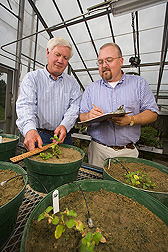Controlling Tropical Spiderwort in the Southeast
|
|
Farmers in the Southeast are facing a fast-spreading weed called tropical spiderwort, Commelina benghalensis (also known as “Benghal dayflower”). This native of Africa and south Asia is currently the most troublesome weed in Georgia cotton, with annual control costs exceeding $1.2 million, and the second most problematic in peanut. It competes for water and nutrients, and its sprawling dense growth can smother crops.
First observed in Florida in 1928, tropical spiderwort was common in herbarium collections throughout the state by the mid-1930s. It advanced into Georgia, but was not considered a troublesome weed until 1999, according to Theodore Webster, an Agricultural Research Service agronomist in the Crop Protection and Management Research Unit at Tifton, Georgia. He is working with Michael Burton of North Carolina State University; Stanley Culpepper, Tim Flanders, and Tim Grey of the University of Georgia; and Barry Brecke of the University of Florida to monitor the weed’s advances and understand its biology.
“The main reason tropical spiderwort’s become a serious weed has to do with recent changes in cropping systems,” says Webster. “The biggest of these is the widespread use of Roundup-ready crops. This technology helps us to better manage weeds in cotton and increases use of conservation tillage. But tropical spiderwort has a natural tolerance to glyphosate [the active ingredient in the herbicide Roundup], so it’s preadapted to that change. It also tolerates other common herbicides, and those that do control it increase production costs significantly.”
Webster says the spread of tropical spiderwort has coincided with a resurgence in cotton production in Georgia. Cotton acreage increased there from about 260,000 acres in 1989 to nearly 1.3 million acres in 2004, in part due to the success of the boll weevil eradication program. (See “We Don’t Cotton to Boll Weevil ’Round Here Anymore,” Agricultural Research, February 2003, p. 4.) Compared to the crops that were displaced (corn and soybean), cotton is a weak competitor with tropical spiderwort.
“We started from square one with this weed in 1999,” says Webster, “because there was little information on how to manage it in crops. We found that it emerges later in the growing season than most weeds, so planting cotton early gives the crop a head start before tropical spiderwort emerges.”
|
|
The impact of tropical spiderwort has recently moved beyond cottonfields. In autumn 2005, container ornamentals contaminated with the weed were discovered in retail outlets in North Carolina. The plants had been shipped from a South Carolina nursery. Tropical spiderwort is on the Federal Noxious Weed List, meaning that movement across state boundaries is prohibited. Halting further spread of this weed is crucial in minimizing control costs throughout the region.
So how do you spot tropical spiderwort? “The easiest way to identify it is by the presence of underground flowers,” says Webster. “Of the 250,000 species of flowering plants, only 36 have underground flowers. Tropical spiderwort is the only known dayflower species in the United States with underground flowers.”—By Sharon Durham, Agricultural Research Service Information Staff.
This research is part of Crop Protection and Quarantine, an ARS National Program (#304) described on the World Wide Web at www.nps.ars.usda.gov.
Theodore M. Webster is in the USDA-ARS Crop Protection and Management Research Unit, 115 Coastal Way, Tifton, GA 31793; phone (229) 386-3363, fax (229) 386-3437.
"Controlling Tropical Spiderwort in the Southeast" was published in the September 2006 issue of Agricultural Research magazine.









